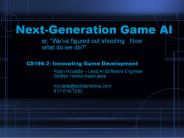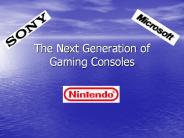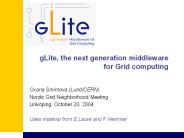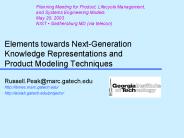Next Generation Memory Industry PowerPoint PPT Presentations
All Time
Recommended
The next-generation memory market is expected to grow at a CAGR 8.50% during the forecast period 2021-2026. Memory solutions based on charge storage are steadily approaching the physical limits of scalability. This has led to the demand for next-generation memory solutions that offer excellent scalability, exhibit low operating voltage, have low power consumption, offer high operational speed, display increased endurance, have long retention time, and possess a simple structure. View Complete Report @ https://whipsmartmi.com/Report/Next_Generation-Memory-Market
| PowerPoint PPT presentation | free to download
[230 Pages Report] Next Generation Memory Market analysis & forecast report categorizes global market by Technology (Nonvolatile memory (MRAM, FRAM, PCM, and RRAM), Volatile Memory (DRAM (T-RAM, T-T-RAM, and others) and SRAM (Z-RAM and others)), Application & Geography
| PowerPoint PPT presentation | free to download
Next-Generation Memory Market by Technology (Volatile (HMC and HBM), and Nonvolatile (MRAM, FRAM, RERAM, 3D XPoint, NRAM)), Wafer Size (200 mm, 300 mm, and 450 mm), Application, and Geography
| PowerPoint PPT presentation | free to download
Next-Generation Memory Market by Technology (Volatile (HMC and HBM), and Nonvolatile (MRAM, FRAM, RERAM, 3D XPoint, NRAM)), Wafer Size (200 mm, 300 mm, and 450 mm), Application, and Geography
| PowerPoint PPT presentation | free to download
Next Generation Memory Devices
| PowerPoint PPT presentation | free to view
Traditional memory technologies have limitations in scalability and storage. There is a need for next generation memory technologies with upgraded architecture and lower power consumption. Next generation memory technologies are becoming necessary due to the increasing demand for newer memory solutions with improved performance and reduced power consumption.
| PowerPoint PPT presentation | free to download
In this report, the United States Next Generation Memory market is valued at USD XX million in 2016 and is expected to reach USD XX million by the end of 2022, growing at a CAGR of XX% between 2016 and 2022.
| PowerPoint PPT presentation | free to download
Advanced and innovative features of DDR4 designs enable high speed operation and broad applicability in a variety including servers, laptops, desktop PCs and consumer products. It aims at simplifying migration and enabling adoption of an industry-wide standard.
| PowerPoint PPT presentation | free to download
Recent research report published by MarketsandMarkets forecast that the total market for next generation memory is expected to reach $90.74 billion by 2017 at an estimated CAGR of 7.3% from 2012 to 2017.
| PowerPoint PPT presentation | free to download
The Next Gen Memory market was valued at US$ 2.28 Bn in 2017 and is projected to reach US$ US$ 26.57 Bn by 2027; it is expected to grow at a CAGR of 29.4% from 2019 to 2027.
| PowerPoint PPT presentation | free to download
Next generation memory technologies covered in this report are Magnetoresistive Random-Access Memory (MRAM), Ferroelectric RAM (FRAM), Phase-change memory (PCM), and Resistive Random-Access Memory (RRAM), among others
| PowerPoint PPT presentation | free to download
Next Generation Memory Market from 2012 to 2017, By Technology (DRAM, SRAM, Flash Memory, Memristor, Magneto Resistive RAM (MRAM), Phase Change RAM (PCRAM), Ferroelectric RAM), Application and Geography
| PowerPoint PPT presentation | free to download
Next generation memory technologies covered in this report are Magnetoresistive Random-Access Memory (MRAM), Ferroelectric RAM (FRAM), Phase-change memory (PCM), and Resistive Random-Access Memory (RRAM), among others. Out of these memories, only MRAM and FeRAM account for a reasonable market share and they are quite commercialized in the market. MRAM memory technology is well commercialized and assures a high capacity; it also improves memory solutions for the high end consumer electronics devices.
| PowerPoint PPT presentation | free to download
[230 Pages Report] Next Generation Memory Market analysis & forecast report categorizes global market by Technology (Nonvolatile memory (MRAM, FRAM, PCM, and RRAM), Volatile Memory (DRAM (T-RAM, T-T-RAM, and others) and SRAM (Z-RAM and others)), Application & Geography
| PowerPoint PPT presentation | free to download
[230 Pages Report] Next Generation Memory Market analysis & forecast report categorizes global market by Technology (Nonvolatile memory (MRAM, FRAM, PCM, and RRAM), Volatile Memory (DRAM (T-RAM, T-T-RAM, and others) and SRAM (Z-RAM and others)), Application & Geography.
| PowerPoint PPT presentation | free to download
[230 Pages Report] Next Generation Memory Market analysis & forecast report categorizes global market by Technology (Nonvolatile memory (MRAM, FRAM, PCM, and RRAM), Volatile Memory (DRAM (T-RAM, T-T-RAM, and others) and SRAM (Z-RAM and others)), Application & Geography."
| PowerPoint PPT presentation | free to download
Next generation memory technologies covered in this report are Magnetoresistive Random-Access Memory (MRAM), Ferroelectric RAM (FRAM), Phase-change memory (PCM), and Resistive Random-Access Memory (RRAM), among others. Out of these memories, only MRAM and FeRAM account for a reasonable market share and they are quite commercialized in the market. MRAM memory technology is well commercialized and assures a high capacity; it also improves memory solutions for the high end consumer electronics devices.
| PowerPoint PPT presentation | free to download
Next generation memory is used for various applications such as enterprise, industrial and automotive to store and manage information, which is expected to augment market growth over the next six years. For More Information Visit - http://www.grandviewresearch.com/industry-analysis/next-generation-memory-market
| PowerPoint PPT presentation | free to download
Strong research over the past few years has led to evolution of several emerging non-volatile memory technologies such as MRAM, PCRAM, RRAM, and ZRAM, among others. With the advent of the latest devices, applications, and consumer electronics products, the need for advanced memory technologies is justified. The rising market for smartphones and tablets is boosting the mobile dynamic RAM market and it is expected to increase further, due to the increasing smartphones’ and tablets’ market.
| PowerPoint PPT presentation | free to download
The global next generation memory market is witnessing a very high growth rate as the need for advanced high density memories that can cater to the needs of the ever evolving complex computing systems is increasing.
Next-Generation Game AI. or, 'We've figured out shooting. Now what do we do? ... AAA title cost jumping from $2-10M for Xbox/PS2 to $10-30M for Xbox360/PS3 ' ...
| PowerPoint PPT presentation | free to download
... Processor & Development Tools. YS Kim. Field Application Engineer ... Hardware, software, and development environment to create a total solution. Page 11 ...
| PowerPoint PPT presentation | free to view
... layer-2 technologies Importance of building and deploying Bridging the gap between ... live streaming of audio/video to many clients Intermediate nodes ...
| PowerPoint PPT presentation | free to download
Reading for today: Sections 5.1 5.4, (Jouppi article) Reading for ... Current SDRAM yield very high: 80% ENGS 116 Lecture 14. 6. Main Memory Performance ...
| PowerPoint PPT presentation | free to view
Minimal fixed format packet/cell states between processing stages ... Rosetta FPGA for Utopia 2, 3 interface. PCI Interface. 32-Bit @ 66 MHz. Applications ...
| PowerPoint PPT presentation | free to view
Why create a new expansion solution when you can add more features. to the handhelds instead? ... Add to the cost of the device ...
| PowerPoint PPT presentation | free to view
The Next Generation of Gaming Consoles History of the Last Gen Sony had the #1 Console (PS2), was also the oldest and weakest, but had strong developer support ...
| PowerPoint PPT presentation | free to download
Next generation memories are the emerging non-volatile memory technologies, which are expected to replace existing memories. Not all existing memories will be replaced though. Next generation memories majorly targets the non-volatile memories such as NAND and NOR. High write and read latency, scalability, high endurance etc.
TITAN: A Next-Generation Infrastructure for Integrating and Communication David E. Culler Computer Science Division U.C. Berkeley NSF Research Infrastructure Meeting
| PowerPoint PPT presentation | free to download
Free view report synopsis @ http://goo.gl/uIVlKs . The exponentially increasing demand for an enriched end-user experience and increased performance in next-generation mainstream computing applications is driving the market for high-density Hybrid Memory Cube and High-Bandwidth Memory devices. The DRAM memory manufacturing industry is expected to face significant challenges over the next six to eight years as it would witness the evolution of these memory technologies.
| PowerPoint PPT presentation | free to download
The Next Generation in Enterprise Security. Presented by William ... VMS. True-64. Wintel. Secure Middleware Integration. CORBA. DCE. Tivoli Identity Manager ...
| PowerPoint PPT presentation | free to download
HYDRA (Hyperspectral Data Research Application) enables interrogation of ... HYDRA RGB composite tool applied to MSG SEVIRI channels. ... Complete HYDRA integration ...
| PowerPoint PPT presentation | free to view
Continued Dominant Position of AsiaInfo in China's Telecom and Internet ... Converged multiple services. today. future. Future Operators. Network operators ...
| PowerPoint PPT presentation | free to view
Exploit new Globus GK and Condor-C (close interaction with Globus and Condor team) ... Globus Gatekeeper, Condor-C, PBS/LSF , 'Pull component' (AliEn CE) WN ...
| PowerPoint PPT presentation | free to download
How to Create the Next Generation of Chinese Heroes Bill Bodri
| PowerPoint PPT presentation | free to download
and Systems Engineering Models May 20, 2003 NIST Gaithersburg MD (via telecon) Elements towards Next-Generation Knowledge Representations and
| PowerPoint PPT presentation | free to download
| PowerPoint PPT presentation | free to download
G ANT 5 Gbps between Europe and New York City now ... Local data collection to capture data at times of network instability. Enhance active probing ...
| PowerPoint PPT presentation | free to view
The Facts. A unified management architecture/framework is needed for productivity improvement ... modify implementation and import/export data to fit their need ...
| PowerPoint PPT presentation | free to view
How to Create the Next. Generation of Chinese Heroes. Bill Bodri ... their mother wanted to create heroes, so she sacrificed to feed them brain nutrient foods ...
| PowerPoint PPT presentation | free to download
The Next Generation Data Storage Technologies Market deals with the data and storage problem that might be faced by many companies and organizations such as IT firms, Data Centers, Automotive industries and others.
| PowerPoint PPT presentation | free to download
First magnetostrictive position feedback sensor (1974) ... HOURS of troubleshooting time without the need for voltmeter or oscilloscope ...
| PowerPoint PPT presentation | free to view
Next Generation 4D Distributed Modeling and Visualization of Battlefield
| PowerPoint PPT presentation | free to download
A fashionable view: 'the next generation is 'Knowledge Management' The School of ... They need to become fashionable. like Filofaxes? ...
| PowerPoint PPT presentation | free to view
Multiple views in a knowledge representation. Declarative thinking ... Constrained Object Panorama. for Multi-Fidelity CAD-CAE Interoperability ...
| PowerPoint PPT presentation | free to download
1. Reduce Misses via Larger Block Size. 2. Reduce Misses via Higher Associativity ... Physical address space is halved, lower half memory addresses and upper half I/O ...
| PowerPoint PPT presentation | free to view
CCS machine development plan for post-peta scale computing and Japanese the next generation supercomputer project Mitsuhisa Sato CCS, University of Tsukuba
| PowerPoint PPT presentation | free to view
... from the speaker, (poor quality but so what, it's FREE) ... Recorded and make MP3 out of it. Copy content for example. Take a screen shot, digital camera? ...
| PowerPoint PPT presentation | free to download
AMD. 2. Server & Workstation Business Segment. AMD64 Brand Architecture ... Three (coherent capable) HyperTransport links per AMD Opteron CPU (8xx Series) ...
| PowerPoint PPT presentation | free to view
Erik P. DeBenedictis. Sandia National Laboratories. February 23, 2006 ... Erik is now on ITRS ERD committee. What is scientifically feasible for Gov't funding? ...
| PowerPoint PPT presentation | free to view
Panel: Next Generation Grid Applications Barriers and Prospects for Petaflops Grid Nodes The Bright
| PowerPoint PPT presentation | free to view
Double Data Rate SDRAM The Next Generation An overview of the industry roadmap for main system memory technology, and details on DDR which represents the latest ...
| PowerPoint PPT presentation | free to download
1.1 Three great inventions in telecommunication ... (He was an undertaker) The Internet. 1959: Invention of the basic principle of packet ...
[230 Pages Report] Next Generation Memory Market analysis & forecast report categorizes global market by Technology (Nonvolatile memory (MRAM, FRAM, PCM, and RRAM), Volatile Memory (DRAM (T-RAM, T-T-RAM, and others) and SRAM (Z-RAM and others)), Application & Geography
| PowerPoint PPT presentation | free to download
[228 Pages Report] Industrial Internet of Things (IIoT) Market forecast report categorizes global market by Technology (Wired, Wireless), Industry Verticals (Manufacturing, Transportation, Retail, Healthcare & others), Components (Sensors, Memory & Processors, Networking Components, RFID & others) & Geography.
| PowerPoint PPT presentation | free to download
Security in the industry H/W & S/W What is AMD s enhanced virus protection all about? What s coming next? Presented by: Micha Moffie Outline Security ...
| PowerPoint PPT presentation | free to download
























































